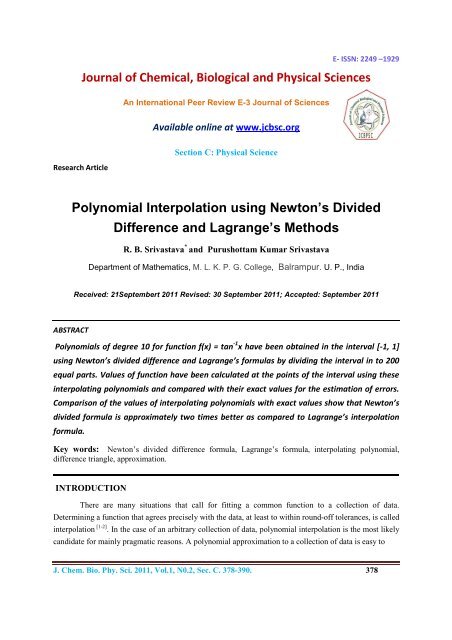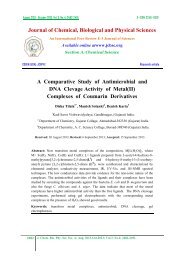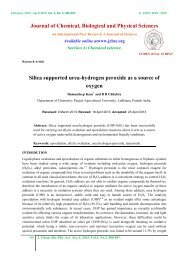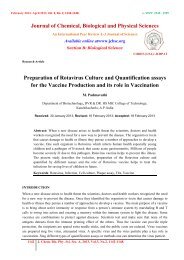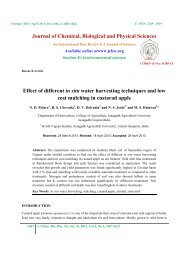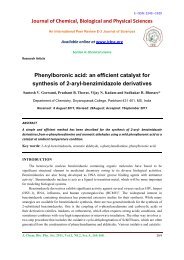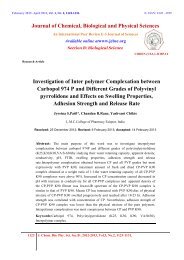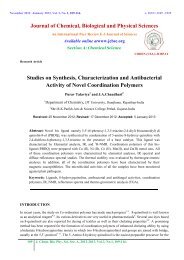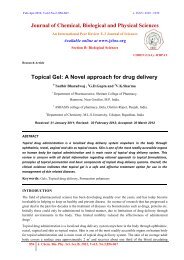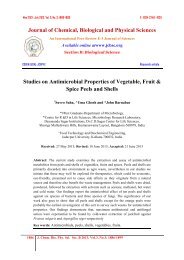Polynomial Interpolation using Newton's Divided Difference and ...
Polynomial Interpolation using Newton's Divided Difference and ...
Polynomial Interpolation using Newton's Divided Difference and ...
Create successful ePaper yourself
Turn your PDF publications into a flip-book with our unique Google optimized e-Paper software.
E- ISSN: 2249 –1929<br />
Journal of Chemical, Biological <strong>and</strong> Physical Sciences<br />
An International Peer Review E-3 Journal of Sciences<br />
Available online at www.jcbsc.org<br />
Research Article<br />
Section C: Physical Science<br />
<strong>Polynomial</strong> <strong>Interpolation</strong> <strong>using</strong> Newton’s <strong>Divided</strong><br />
<strong>Difference</strong> <strong>and</strong> Lagrange’s Methods<br />
R. B. Srivastava * <strong>and</strong> Purushottam Kumar Srivastava<br />
Department of Mathematics, M. L. K. P. G. College, Balrampur. U. P., India<br />
Received: 21Septembert 2011 Revised: 30 September 2011; Accepted: September 2011<br />
ABSTRACT<br />
<strong>Polynomial</strong>s of degree 10 for function f(x) = tan -1 x have been obtained in the interval [-1, 1]<br />
<strong>using</strong> Newton’s divided difference <strong>and</strong> Lagrange’s formulas by dividing the interval in to 200<br />
equal parts. Values of function have been calculated at the points of the interval <strong>using</strong> these<br />
interpolating polynomials <strong>and</strong> compared with their exact values for the estimation of errors.<br />
Comparison of the values of interpolating polynomials with exact values show that Newton’s<br />
divided formula is approximately two times better as compared to Lagrange’s interpolation<br />
formula.<br />
Key words: Newton’s divided difference formula, Lagrange’s formula, interpolating polynomial,<br />
difference triangle, approximation.<br />
INTRODUCTION<br />
There are many situations that call for fitting a common function to a collection of data.<br />
Determining a function that agrees precisely with the data, at least to within round-off tolerances, is called<br />
interpolation [1-2] . In the case of an arbitrary collection of data, polynomial interpolation is the most likely<br />
c<strong>and</strong>idate for mainly pragmatic reasons. A polynomial approximation to a collection of data is easy to<br />
J. Chem. Bio. Phy. Sci. 2011, Vol.1, N0.2, Sec. C. 378-390. 378
<strong>Polynomial</strong>....<br />
R. B. Srivastava et al.<br />
determine in various ways, <strong>and</strong> polynomials have easily computed derivatives <strong>and</strong> integrals that might be<br />
useful if the derivative or integral [3-5] of the function underlying the data is needed. However, a<br />
polynomial of degree n-1 is generally required to satisfy a set of n conditions, <strong>and</strong> polynomials of even<br />
moderately high degree are likely to have a high degree of variation except where explicitly constrained.<br />
This means that in order to obtain stable approximating polynomials either the number of specified<br />
conditions must be kept small, which may not be a reasonable restriction, or, more likely, the conditions<br />
are only required to be satisfied in an approximate way. The problem of approximating [6] a known<br />
function with a simpler function follows a pattern similar to that of fitting a function to a collection of<br />
data. There are many reasons why such an approximation might be required.<br />
The branch of mathematical statistics devoted to the inference of accurate conclusions about the<br />
numerical values of approximately measured quantities, as well as on the errors in the measurements.<br />
Repeated measurements of one <strong>and</strong> the same constant quantity generally give different results, since<br />
every measurement contains a certain error. There are three basic types of error: systematic, gross <strong>and</strong><br />
r<strong>and</strong>om. Systematic errors always either overestimate or underestimate the results of measurements <strong>and</strong><br />
arise for specific reasons (incorrect set-up of measuring equipment, the effect of environment, etc.), which<br />
systematically affect the measurements <strong>and</strong> alter them in one direction. The estimation of systematic<br />
errors is achieved <strong>using</strong> methods which go beyond the confines of mathematical statistics. Gross errors<br />
(often called outliers) arise from miscalculations, incorrect reading of the measuring equipment, etc. The<br />
results of measurements which contain gross errors differ greatly from other results of measurements <strong>and</strong><br />
are therefore often easy to identify. R<strong>and</strong>om errors [16-19] arise from various reasons which have an<br />
unforeseen effect on each of the measurements, both in overestimating <strong>and</strong> in underestimating results.<br />
The main contents of approximation theory concern the approximation of functions. Its<br />
foundations are laid by the work of P. L. Chebyshev (1854–1859) on best uniform approximation of<br />
functions by polynomials <strong>and</strong> by K. Weierstrass, who in 1885 established that in principle it is possible to<br />
approximate a continuous function on a finite interval by polynomials with arbitrary pre-given error.<br />
Data interpolation [7-10] is one of the most important tasks in geophysical data processing. Its<br />
importance is increasing with the development of 3-D seismics, since most of the modern 3-D acquisition<br />
geometries carry non-uniform spatial distribution of seismic records. Without a careful interpolation,<br />
acquisition irregularities may lead to unwanted artifacts at the imaging step (Gardner <strong>and</strong> Canning, 1994;<br />
Chemingui <strong>and</strong> Biondi, 1996). The interpolation problem in geophysics implies interpolating irregularly<br />
sampled data to a regular grid. In general, this problem requires a regularized inversion scheme, such as<br />
the method of inversion to zero offset (Ronen et al., 1991, 1995).<br />
Newton’s forward formula [9-11] is appropriate to apply only when the unknown value lies near the<br />
beginning of the table while Newton’s backward formula is usually applied when the unknown value to<br />
be interpolated lies near the end of the table [25, 26] . Lagrange’s formula for interpolation is applicable for<br />
any type of observation [4] but when the observations are given at equi-spaced values of arguments, the<br />
formulas <strong>using</strong> various order differences are found to be more convenient <strong>and</strong> easy to apply rather than<br />
Lagrange’s interpolation formula. In the case, the values of the arguments are unequally spaced; we<br />
J. Chem. Bio. Phy. Sci. 2011, Vol.1, N0.2, Sec.C.378-383. 379
<strong>Polynomial</strong>....<br />
R. B. Srivastava et al.<br />
should use Newton’s divided difference formula to represent the function [12-15, 20-24] .<br />
METHODOLOGY<br />
Lagrange’s formula for equal intervals: Interval [a, b] has been divided into 10 equal parts with the<br />
help of the points<br />
a=x 0 , x 1 , x 2 , x 3 , x 4 , x 5 , x 6 , x 7 , x 8 , x 9 , x 10 =b<br />
<strong>and</strong> y i = f(x i ); where i=0,1, 2, …. , 10; have been calculated.<br />
In this case, the Lagrange’s formula [4-6]<br />
( x − x )( x − x )....( x − x ) ( x − x )( x − x )( x − x )....( x − x )<br />
f x f x f x<br />
1 2 10 0 2 3 10<br />
( ) = ( 0) +<br />
( 1)<br />
( x0 − x1)( x0 − x 2)....( x0 − x10) ( x1 − x0)( x1 − x2)( x1 − x3)....( x1 − x10)<br />
( x − x0)( x − x1)....( x − x9)<br />
.... f ( x10)<br />
( x10 − x0)( x10 − x1)....( x10 − x9)<br />
+ +<br />
can be solved to give<br />
f(x) = c 0 + c 1 x + c 2 x 2 + ….. + c 10 x 10<br />
Where<br />
c =<br />
j=10<br />
∑<br />
i j j<br />
j=0<br />
b y p(j,10,10-i)<br />
b i =(-1) i /{i! (10-i)! h 10 }<br />
p(i,10,j)=sum of product of j terms in all combinations among x 0 , x 1 ,…,x i-1 ,x i+1 ,…, x 10<br />
We have developed a program in C++ for obtaining the polynomial interpolation of the functions<br />
<strong>using</strong> Lagrange’s formula.<br />
Newton’s divided difference formula: The Lagrange interpolation formula involves very considerable<br />
computation <strong>and</strong> its use can be quite risky. It is much more efficient to use the divided differences<br />
method for interpolation [11, 16, 26] .<br />
We have divided the interval [a, b] into 10 equal parts with the help of the points<br />
a=x 0 , x 1 , x 2 , x 3 , x 4 , x 5 , x 6 , x 7 , x 8 , x 9 , x 10 =b<br />
<strong>and</strong> calculated y i = f(x i ) where i=0,1, 2, …. , 10. We have also drawn difference triangle for the function<br />
y=f(x). <strong>Difference</strong> triangle has been drawn by <strong>using</strong> the formula<br />
d n y i = d n-1 y i - d n-1 y i-1 where n, i = 0,1, 2, …. , 10<br />
J. Chem. Bio. Phy. Sci. 2011, Vol.1, N0.2, Sec. C. 378-390. 380
<strong>Polynomial</strong>....<br />
R. B. Srivastava et al.<br />
Now, the Newton’s divided difference formula<br />
f(x) = a 0 + a 1 (x-x 0 ) + a 2 (x-x 0 )(x-x 1 ) + …. + a 10 (x-x 0 )(x-x 1 )….(x-x 9 )<br />
Where a n = (d n y 0 )/(n!h n ); n = 0,1, 2, …. , 10<br />
Becomes<br />
f(x) = c 0 + c 1 x + c 2 x 2 + ….. + c 10 x 10<br />
Where<br />
c0=a0-a1*p(1,1)+a2*p(2,2)-a3*p(3,3)+a4*p(4,4)-a5*p(5,5)+a6*p(6,6)-a7*p(7,7)<br />
+a8*p(8,8) -a9*p(9,9)+a10*p(10,10);<br />
c1=a1-a2*p(2,1)+a3*p(3,2)-a4*p(4,3)+a5*p(5,4)-a6*p(6,5)+a7*p(7,6)-a8*p(8,7)<br />
+a9*p(9,8) -a10*p(10,9);<br />
c2=a2-a3*p(3,1)+a4*p(4,2)-a5*p(5,3)+a6*p(6,4)-a7*p(7,5)+a8*p(8,6)-a9*p(9,7)<br />
+a10*p(10,8);<br />
c3=a3-a4*p(4,1)+a5*p(5,2)-a6*p(6,3)+a7*p(7,4)-a8*p(8,5)+a9*p(9,6)-a10*p(10,7);<br />
c4=a4-a5*p(5,1)+a6*p(6,2)-a7*p(7,3)+a8*p(8,4)-a9*p(9,5)+a10*p(10,6);<br />
c5=a5-a6*p(6,1)+a7*p(7,2)-a8*p(8,3)+a9*p(9,4)-a10*p(10,5);<br />
c6=a6-a7*p(7,1)+a8*p(8,2)-a9*p(9,3)+a10*p(10,4);<br />
c7=a7-a8*p(8,1)+a9*p(9,2)-a10*p(10,3);<br />
c8=a8-a9*p(9,1)+a10*p(10,2);<br />
c9=a9-a10*p(10,1);<br />
c10=a10;<br />
p(i,j)=summation of the product of j elements in all combinations among x 0 ,x 1 ,..,x i-1<br />
We have developed a program in C++ for obtaining the polynomial interpolation of the functions<br />
<strong>using</strong> Newton’s divided difference formula.<br />
J. Chem. Bio. Phy. Sci. 2011, Vol.1, N0.2, Sec.C.378-383. 381
<strong>Polynomial</strong>....<br />
R. B. Srivastava et al.<br />
RESULT AND DISCUSSION<br />
We have divided the interval into 10 equal parts with the help of the points x 0 ,x 1 ,…..,x 10 such that<br />
x i =x 0 +ih, i=0,1,2,…., 10, h=(b-a)/n, n=10<br />
<strong>Polynomial</strong> obtained by Newton’s divided difference formula <strong>using</strong> the developed C++ program<br />
is given belowf(x)=<br />
0.00000002 + 0.99996847 x - 0.00000002 x 2 - 0.33215311 x 3 + 0.00000040 x 4 + 0.18856475 x 5 -<br />
0.00000302 x 6 - 0.09845734 x 7 + 0.00000549 x 8 + 0.02747540 x 9 -0.00000289 x 10<br />
<strong>Polynomial</strong> obtained by Lagrange’s formula for equal intervals <strong>using</strong> the developed C++ program<br />
is given belowf(x)=<br />
0.99996847 x -0.00000023 x 2 -0.33215025 x 3 -0.00003796 x 4 + 0.18855174 x 5 -0.00002446 x 6 -<br />
0.09860489 x 7 + 0.00003787 x 8 + 0.02746514 x 9 + 0.00000052x 10<br />
Actual value of f(x)=tan -1 x, Calculated value of f(x)=tan -1 x by Newton’s interpolating<br />
polynomial, Calculated value of f(x)=tan -1 x by Lagrange’s interpolating polynomial, <strong>Difference</strong> between<br />
actual <strong>and</strong> calculated values of f(x)=tan -1 x by Newton’s interpolating polynomial, <strong>Difference</strong> between<br />
actual <strong>and</strong> calculated values of f(x)=tan -1 x by Lagrange’s interpolating polynomial, Percentage error in<br />
the values of f(x)=tan -1 x calculated by Newton’s interpolating polynomial <strong>and</strong> Percentage error in the<br />
values of f(x)=tan -1 x calculated by Lagrange’s interpolating polynomial at different values of x are given<br />
in Table-1. Graph between actual values of f(x)=tan -1 x <strong>and</strong> the values calculated by Newton’s<br />
interpolating polynomial at different points in the interval [-1,1] separated by the distance 0.01 is given in<br />
Graph-1.<br />
1<br />
0.5<br />
0<br />
-0.5<br />
-1<br />
Actual value of f(x)=tan-1 x<br />
Calculated value of f(x)=tan-1 x by Newton’s interpolating polynomial<br />
x<br />
Graph-1: Graph between actual values of f(x)=tan -1 x <strong>and</strong> the values calculated by Newton’s interpolating<br />
polynomial at different points in the interval [-1,1]<br />
Graph between actual values of f(x)=tan -1 x <strong>and</strong> the values calculated by Lagrange’s interpolating<br />
polynomial at different points in the interval [-1,1] separated by the distance 0.01 is given in Graph-2.<br />
J. Chem. Bio. Phy. Sci. 2011, Vol.1, N0.2, Sec. C. 378-390. 382
<strong>Polynomial</strong>....<br />
R. B. Srivastava et al.<br />
<strong>Difference</strong> between actual <strong>and</strong> calculated values of the function f(x)=tan -1 x by Newton’s interpolating<br />
polynomial is shown in Graph-3. <strong>Difference</strong> between actual <strong>and</strong> calculated values of the function<br />
f(x)=tan -1 x by Lagrange’s interpolating polynomial is shown in Graph-4. Maximum percentage error in<br />
the values obtained by Newton’s interpolating polynomial is 0.014126% <strong>and</strong> by Lagrange’s interpolating<br />
polynomial is 0.03246%. Thus in the case of the function tan -1 x, Newton’s interpolating polynomial is<br />
approximately 2 times better than Lagrange’s interpolating polynomial.<br />
1<br />
f(x)<br />
0<br />
-1<br />
x<br />
Actual value of f(x)=tan-1 x<br />
Calculated value of f(x) =tan-1 x by Lagrange’s interpolating polynomial<br />
Graph-2: Graph between actual values of f(x)=tan -1 x <strong>and</strong> the values calculated by Lagrange’s interpolating<br />
polynomial at different points in the interval [-1,1]<br />
0.00015<br />
<strong>Difference</strong> betw een actual <strong>and</strong> calculated values of f(x)=tan-1 x by New ton’s interpolating<br />
polynomial<br />
Error in f(x)<br />
0.0001<br />
0.00005<br />
0<br />
<strong>Difference</strong> between actual <strong>and</strong> calculated values of f(x)=tan-1 x by<br />
Newton’s interpolating polynomial<br />
Graph-3: <strong>Difference</strong> between actual <strong>and</strong> calculated values of the function f(x)=tan -1 x by Newton’s<br />
interpolating polynomial<br />
J. Chem. Bio. Phy. Sci. 2011, Vol.1, N0.2, Sec.C.378-383. 383
<strong>Polynomial</strong>....<br />
R. B. Srivastava et al.<br />
<strong>Difference</strong> between actual <strong>and</strong> calculated values of f(x)=tan-1 x by Lagrange’s<br />
interpolating polynomial<br />
Error in f(x)<br />
0.0003<br />
0.00025<br />
0.0002<br />
0.00015<br />
0.0001<br />
0.00005<br />
0<br />
<strong>Difference</strong> between actual <strong>and</strong> calculated values of f(x)=tan-1 x by Lagrange’s<br />
interpolating polynomial<br />
Graph-4: <strong>Difference</strong> between actual <strong>and</strong> calculated values of the function f(x)=tan -1 x by Lagrange’s<br />
interpolating polynomial<br />
CONCLUSION<br />
Newton’s interpolating polynomial is approximately 2 times better than Lagrange’s interpolating<br />
polynomial.<br />
Table-1: Actual value of f(x)=tan -1 x, Calculated value of f(x)=tan -1 x by Newton’s interpolating polynomial,<br />
Calculated value of f(x) =tan -1 x by Lagrange’s interpolating polynomial, <strong>Difference</strong> between actual <strong>and</strong><br />
calculated values of f(x)=tan -1 x by Newton’s interpolating polynomial, <strong>Difference</strong> between actual <strong>and</strong><br />
calculated values of f(x)=tan -1 x by Lagrange’s interpolating polynomial, Percentage error in the values of<br />
f(x)=tan -1 x calculated by Newton’s interpolating polynomial <strong>and</strong> Percentage error in the values of f(x)=tan -1 x<br />
calculated by Lagrange’s interpolating polynomial at different values of x<br />
x<br />
Actual value<br />
of f(x)=tan -1 x<br />
Calculated<br />
value of<br />
f(x)=tan -1 x by<br />
Newton’s<br />
interpolating<br />
polynomial<br />
Calculated<br />
value of f(x)<br />
=tan -1 x by<br />
Lagrange’s<br />
interpolating<br />
polynomial<br />
<strong>Difference</strong><br />
between actual<br />
<strong>and</strong> calculated<br />
values of<br />
f(x)=tan -1 x by<br />
Newton’s<br />
interpolating<br />
polynomial<br />
<strong>Difference</strong><br />
between actual<br />
<strong>and</strong> calculated<br />
values of<br />
f(x)=tan -1 x by<br />
Lagrange’s<br />
interpolating<br />
polynomial<br />
Percentage<br />
error in the<br />
values of<br />
f(x)=tan -1 x<br />
calculated by<br />
Newton’s<br />
interpolating<br />
polynomial<br />
Percentage<br />
error in the<br />
values of<br />
f(x)=tan -1 x<br />
calculated by<br />
Lagrange’s<br />
interpolating<br />
polynomial<br />
-1.00 -0.78539819 -0.78539813 -0.78525442 0.00000006 0.00014377 -0.00000764 -0.01830536<br />
-0.99 -0.78037310 -0.78033477 -0.78020257 0.00003833 0.00017053 -0.00491175 -0.02185237<br />
-0.98 -0.77529752 -0.77523106 -0.77510965 0.00006646 0.00018787 -0.00857219 -0.02423199<br />
-0.97 -0.77017093 -0.77008504 -0.76997370 0.00008589 0.00019723 -0.01115207 -0.02560860<br />
-0.96 -0.76499283 -0.76489466 -0.76479250 0.00009817 0.00020033 -0.01283280 -0.02618717<br />
-0.95 -0.75976276 -0.75965792 -0.75956470 0.00010484 0.00019806 -0.01379904 -0.02606866<br />
-0.94 -0.75448024 -0.75437355 -0.75428826 0.00010669 0.00019198 -0.01414086 -0.02544533<br />
-0.93 -0.74914467 -0.74904001 -0.74896199 0.00010466 0.00018268 -0.01397060 -0.02438514<br />
-0.92 -0.74375564 -0.74365568 -0.74358469 0.00009996 0.00017095 -0.01343990 -0.02298470<br />
-0.91 -0.73831260 -0.73821950 -0.73815507 0.00009310 0.00015753 -0.01260983 -0.02133649<br />
-0.90 -0.73281515 -0.73273033 -0.73267180 0.00008482 0.00014335 -0.01157454 -0.01956155<br />
-0.89 -0.72726274 -0.72718722 -0.72713417 0.00007552 0.00012857 -0.01038414 -0.01767862<br />
-0.88 -0.72165489 -0.72158915 -0.72154129 0.00006574 0.00011360 -0.00910962 -0.01574160<br />
J. Chem. Bio. Phy. Sci. 2011, Vol.1, N0.2, Sec. C. 378-390. 384
<strong>Polynomial</strong>....<br />
R. B. Srivastava et al.<br />
x<br />
Actual value<br />
of f(x)=tan -1 x<br />
Calculated<br />
value of<br />
f(x)=tan -1 x by<br />
Newton’s<br />
interpolating<br />
polynomial<br />
Calculated<br />
value of f(x)<br />
=tan -1 x by<br />
Lagrange’s<br />
interpolating<br />
polynomial<br />
<strong>Difference</strong><br />
between actual<br />
<strong>and</strong> calculated<br />
values of<br />
f(x)=tan -1 x by<br />
Newton’s<br />
interpolating<br />
polynomial<br />
<strong>Difference</strong><br />
between actual<br />
<strong>and</strong> calculated<br />
values of<br />
f(x)=tan -1 x by<br />
Lagrange’s<br />
interpolating<br />
polynomial<br />
Percentage<br />
error in the<br />
values of<br />
f(x)=tan -1 x<br />
calculated by<br />
Newton’s<br />
interpolating<br />
polynomial<br />
Percentage<br />
error in the<br />
values of<br />
f(x)=tan -1 x<br />
calculated by<br />
Lagrange’s<br />
interpolating<br />
polynomial<br />
-0.87 -0.71599120 -0.71593535 -0.71589220 0.00005585 0.00009900 -0.00780038 -0.01382699<br />
-0.86 -0.71027106 -0.71022505 -0.71018612 0.00004601 0.00008494 -0.00647781 -0.01195881<br />
-0.85 -0.70449412 -0.70445752 -0.70442265 0.00003660 0.00007147 -0.00519522 -0.01014487<br />
-0.84 -0.69865990 -0.69863206 -0.69860101 0.00002784 0.00005889 -0.00398477 -0.00842899<br />
-0.83 -0.69276792 -0.69274837 -0.69272047 0.00001955 0.00004745 -0.00282201 -0.00684934<br />
-0.82 -0.68681777 -0.68680555 -0.68678081 0.00001222 0.00003696 -0.00177922 -0.00538134<br />
-0.81 -0.68080896 -0.68080324 -0.68078130 0.00000572 0.00002766 -0.00084018 -0.00406281<br />
-0.80 -0.67474103 -0.67474097 -0.67472160 0.00000006 0.00001943 -0.00000889 -0.00287962<br />
-0.79 -0.66861367 -0.66861856 -0.66860139 0.00000489 0.00001228 -0.00073136 -0.00183664<br />
-0.78 -0.66242641 -0.66243511 -0.66242021 0.00000870 0.00000620 -0.00131335 -0.00093595<br />
-0.77 -0.65617883 -0.65619087 -0.65617776 0.00001204 0.00000107 -0.00183487 -0.00016307<br />
-0.76 -0.64987057 -0.64988494 -0.64987361 0.00001437 0.00000304 -0.00221121 -0.00046779<br />
-0.75 -0.64350128 -0.64351720 -0.64350742 0.00001592 0.00000614 -0.00247397 -0.00095416<br />
-0.74 -0.63707048 -0.63708746 -0.63707924 0.00001698 0.00000876 -0.00266533 -0.00137504<br />
-0.73 -0.63057792 -0.63059539 -0.63058835 0.00001747 0.00001043 -0.00277047 -0.00165404<br />
-0.72 -0.62402320 -0.62404048 -0.62403470 0.00001728 0.00001150 -0.00276913 -0.00184288<br />
-0.71 -0.61740607 -0.61742282 -0.61741811 0.00001675 0.00001204 -0.00271296 -0.00195009<br />
-0.70 -0.61072618 -0.61074191 -0.61073822 0.00001573 0.00001204 -0.00257562 -0.00197142<br />
-0.69 -0.60398316 -0.60399783 -0.60399479 0.00001467 0.00001163 -0.00242888 -0.00192555<br />
-0.68 -0.59717685 -0.59719014 -0.59718782 0.00001329 0.00001097 -0.00222547 -0.00183698<br />
-0.67 -0.59030694 -0.59031856 -0.59031695 0.00001162 0.00001001 -0.00196847 -0.00169573<br />
-0.66 -0.58337325 -0.58338326 -0.58338213 0.00001001 0.00000888 -0.00171588 -0.00152218<br />
-0.65 -0.57637548 -0.57638365 -0.57638299 0.00000817 0.00000751 -0.00141748 -0.00130297<br />
-0.64 -0.56931341 -0.56931984 -0.56931961 0.00000643 0.00000620 -0.00112943 -0.00108903<br />
-0.63 -0.56218702 -0.56219167 -0.56219190 0.00000465 0.00000488 -0.00082713 -0.00086804<br />
-0.62 -0.55499601 -0.55499899 -0.55499935 0.00000298 0.00000334 -0.00053694 -0.00060181<br />
-0.61 -0.54774028 -0.54774177 -0.54774237 0.00000149 0.00000209 -0.00027203 -0.00038157<br />
-0.60 -0.54041976 -0.54041970 -0.54042077 0.00000006 0.00000101 -0.00001110 -0.00018689<br />
-0.59 -0.53303438 -0.53303313 -0.53303421 0.00000125 0.00000017 -0.00023451 -0.00003189<br />
-0.58 -0.52558410 -0.52558166 -0.52558291 0.00000244 0.00000119 -0.00046425 -0.00022641<br />
-0.57 -0.51806885 -0.51806539 -0.51806670 0.00000346 0.00000215 -0.00066786 -0.00041500<br />
-0.56 -0.51048863 -0.51048446 -0.51048595 0.00000417 0.00000268 -0.00081686 -0.00052499<br />
-0.55 -0.50284356 -0.50283879 -0.50284016 0.00000477 0.00000340 -0.00094861 -0.00067615<br />
-0.54 -0.49513361 -0.49512839 -0.49512982 0.00000522 0.00000379 -0.00105426 -0.00076545<br />
-0.53 -0.48735893 -0.48735341 -0.48735493 0.00000552 0.00000400 -0.00113264 -0.00082075<br />
-0.52 -0.47951967 -0.47951406 -0.47951555 0.00000561 0.00000412 -0.00116992 -0.00085919<br />
-0.51 -0.47161594 -0.47161037 -0.47161183 0.00000557 0.00000411 -0.00118105 -0.00087147<br />
-0.50 -0.46364799 -0.46364257 -0.46364406 0.00000542 0.00000393 -0.00116899 -0.00084763<br />
-0.49 -0.45561606 -0.45561087 -0.45561236 0.00000519 0.00000370 -0.00113912 -0.00081209<br />
-0.48 -0.44752038 -0.44751561 -0.44751704 0.00000477 0.00000334 -0.00106587 -0.00074633<br />
-0.47 -0.43936130 -0.43935704 -0.43935838 0.00000426 0.00000292 -0.00096959 -0.00066460<br />
-0.46 -0.43113917 -0.43113542 -0.43113670 0.00000375 0.00000247 -0.00086979 -0.00057290<br />
-0.45 -0.42285436 -0.42285120 -0.42285246 0.00000316 0.00000190 -0.00074730 -0.00044933<br />
-0.44 -0.41450733 -0.41450480 -0.41450596 0.00000253 0.00000137 -0.00061036 -0.00033051<br />
-0.43 -0.40609851 -0.40609667 -0.40609771 0.00000184 0.00000080 -0.00045309 -0.00019700<br />
-0.42 -0.39762846 -0.39762723 -0.39762831 0.00000123 0.00000015 -0.00030933 -0.00003772<br />
J. Chem. Bio. Phy. Sci. 2011, Vol.1, N0.2, Sec.C.378-383. 385
<strong>Polynomial</strong>....<br />
R. B. Srivastava et al.<br />
x<br />
Actual value<br />
of f(x)=tan -1 x<br />
Calculated<br />
value of<br />
f(x)=tan -1 x by<br />
Newton’s<br />
interpolating<br />
polynomial<br />
Calculated<br />
value of f(x)<br />
=tan -1 x by<br />
Lagrange’s<br />
interpolating<br />
polynomial<br />
<strong>Difference</strong><br />
between actual<br />
<strong>and</strong> calculated<br />
values of<br />
f(x)=tan -1 x by<br />
Newton’s<br />
interpolating<br />
polynomial<br />
<strong>Difference</strong><br />
between actual<br />
<strong>and</strong> calculated<br />
values of<br />
f(x)=tan -1 x by<br />
Lagrange’s<br />
interpolating<br />
polynomial<br />
Percentage<br />
error in the<br />
values of<br />
f(x)=tan -1 x<br />
calculated by<br />
Newton’s<br />
interpolating<br />
polynomial<br />
Percentage<br />
error in the<br />
values of<br />
f(x)=tan -1 x<br />
calculated by<br />
Lagrange’s<br />
interpolating<br />
polynomial<br />
-0.41 -0.38909772 -0.38909712 -0.38909808 0.00000060 0.00000036 -0.00015420 -0.00009252<br />
-0.40 -0.38050687 -0.38050687 -0.38050777 0.00000000 0.00000090 0.00000000 -0.00023653<br />
-0.39 -0.37185657 -0.37185711 -0.37185791 0.00000054 0.00000134 -0.00014522 -0.00036035<br />
-0.38 -0.36314753 -0.36314857 -0.36314934 0.00000104 0.00000181 -0.00028638 -0.00049842<br />
-0.37 -0.35438046 -0.35438201 -0.35438275 0.00000155 0.00000229 -0.00043738 -0.00064620<br />
-0.36 -0.34555611 -0.34555802 -0.34555873 0.00000191 0.00000262 -0.00055273 -0.00075820<br />
-0.35 -0.33667538 -0.33667764 -0.33667830 0.00000226 0.00000292 -0.00067127 -0.00086730<br />
-0.34 -0.32773906 -0.32774159 -0.32774213 0.00000253 0.00000307 -0.00077196 -0.00093672<br />
-0.33 -0.31874815 -0.31875083 -0.31875136 0.00000268 0.00000321 -0.00084079 -0.00100706<br />
-0.32 -0.30970353 -0.30970636 -0.30970678 0.00000283 0.00000325 -0.00091378 -0.00104939<br />
-0.31 -0.30060628 -0.30060908 -0.30060956 0.00000280 0.00000328 -0.00093145 -0.00109113<br />
-0.30 -0.29145741 -0.29146019 -0.29146060 0.00000278 0.00000319 -0.00095383 -0.00109450<br />
-0.29 -0.28225803 -0.28226078 -0.28226107 0.00000275 0.00000304 -0.00097429 -0.00107703<br />
-0.28 -0.27300933 -0.27301189 -0.27301225 0.00000256 0.00000292 -0.00093770 -0.00106956<br />
-0.27 -0.26371250 -0.26371482 -0.26371509 0.00000232 0.00000259 -0.00087975 -0.00098213<br />
-0.26 -0.25436872 -0.25437081 -0.25437105 0.00000209 0.00000233 -0.00082164 -0.00091599<br />
-0.25 -0.24497934 -0.24498112 -0.24498132 0.00000178 0.00000198 -0.00072659 -0.00080823<br />
-0.24 -0.23554565 -0.23554711 -0.23554727 0.00000146 0.00000162 -0.00061984 -0.00068776<br />
-0.23 -0.22606906 -0.22607015 -0.22607030 0.00000109 0.00000124 -0.00048215 -0.00054850<br />
-0.22 -0.21655098 -0.21655169 -0.21655183 0.00000071 0.00000085 -0.00032787 -0.00039252<br />
-0.21 -0.20699286 -0.20699319 -0.20699334 0.00000033 0.00000048 -0.00015943 -0.00023189<br />
-0.20 -0.19739622 -0.19739620 -0.19739631 0.00000002 0.00000009 -0.00001013 -0.00004559<br />
-0.19 -0.18776260 -0.18776223 -0.18776233 0.00000037 0.00000027 -0.00019706 -0.00014380<br />
-0.18 -0.17809360 -0.17809288 -0.17809296 0.00000072 0.00000064 -0.00040428 -0.00035936<br />
-0.17 -0.16839081 -0.16838978 -0.16838984 0.00000103 0.00000097 -0.00061167 -0.00057604<br />
-0.16 -0.15865591 -0.15865459 -0.15865465 0.00000132 0.00000126 -0.00083199 -0.00079417<br />
-0.15 -0.14889060 -0.14888903 -0.14888908 0.00000157 0.00000152 -0.00105447 -0.00102088<br />
-0.14 -0.13909659 -0.13909481 -0.13909487 0.00000178 0.00000172 -0.00127969 -0.00123655<br />
-0.13 -0.12927565 -0.12927373 -0.12927377 0.00000192 0.00000188 -0.00148520 -0.00145426<br />
-0.12 -0.11942957 -0.11942754 -0.11942757 0.00000203 0.00000200 -0.00169975 -0.00167463<br />
-0.11 -0.10956018 -0.10955808 -0.10955811 0.00000210 0.00000207 -0.00191675 -0.00188937<br />
-0.10 -0.09966930 -0.09966720 -0.09966724 0.00000210 0.00000206 -0.00210697 -0.00206684<br />
-0.09 -0.08975883 -0.08975676 -0.08975678 0.00000207 0.00000205 -0.00230618 -0.00228390<br />
-0.08 -0.07983065 -0.07982867 -0.07982869 0.00000198 0.00000196 -0.00248025 -0.00245520<br />
-0.07 -0.06988666 -0.06988482 -0.06988484 0.00000184 0.00000182 -0.00263283 -0.00260422<br />
-0.06 -0.05992882 -0.05992715 -0.05992717 0.00000167 0.00000165 -0.00278664 -0.00275327<br />
-0.05 -0.04995905 -0.04995760 -0.04995762 0.00000145 0.00000143 -0.00290238 -0.00286234<br />
-0.04 -0.03997935 -0.03997814 -0.03997815 0.00000121 0.00000120 -0.00302656 -0.00300155<br />
-0.03 -0.02999166 -0.02999073 -0.02999075 0.00000093 0.00000091 -0.00310086 -0.00303418<br />
-0.02 -0.01999799 -0.01999735 -0.01999737 0.00000064 0.00000062 -0.00320032 -0.00310031<br />
-0.01 -0.01000033 -0.00999999 -0.01000001 0.00000034 0.00000032 -0.00339989 -0.00319989<br />
0.00 -0.00000066 -0.00000064 -0.00000066 0.00000002 0.00000000 -3.03030303 0.00000000<br />
0.01 0.00999901 0.00999871 0.00999869 0.00000030 0.00000032 0.00300030 0.00320032<br />
0.02 0.01999667 0.01999607 0.01999605 0.00000060 0.00000062 0.00300050 0.00310052<br />
0.03 0.02999035 0.02998945 0.02998943 0.00000090 0.00000092 0.00300097 0.00306765<br />
0.04 0.03997803 0.03997686 0.03997684 0.00000117 0.00000119 0.00292661 0.00297663<br />
J. Chem. Bio. Phy. Sci. 2011, Vol.1, N0.2, Sec. C. 378-390. 386
<strong>Polynomial</strong>....<br />
R. B. Srivastava et al.<br />
x<br />
Actual value<br />
of f(x)=tan -1 x<br />
Calculated<br />
value of<br />
f(x)=tan -1 x by<br />
Newton’s<br />
interpolating<br />
polynomial<br />
Calculated<br />
value of f(x)<br />
=tan -1 x by<br />
Lagrange’s<br />
interpolating<br />
polynomial<br />
<strong>Difference</strong><br />
between actual<br />
<strong>and</strong> calculated<br />
values of<br />
f(x)=tan -1 x by<br />
Newton’s<br />
interpolating<br />
polynomial<br />
<strong>Difference</strong><br />
between actual<br />
<strong>and</strong> calculated<br />
values of<br />
f(x)=tan -1 x by<br />
Lagrange’s<br />
interpolating<br />
polynomial<br />
Percentage<br />
error in the<br />
values of<br />
f(x)=tan -1 x<br />
calculated by<br />
Newton’s<br />
interpolating<br />
polynomial<br />
Percentage<br />
error in the<br />
values of<br />
f(x)=tan -1 x<br />
calculated by<br />
Lagrange’s<br />
interpolating<br />
polynomial<br />
0.05 0.04995774 0.04995633 0.04995631 0.00000141 0.00000143 0.00282239 0.00286242<br />
0.06 0.05992750 0.05992587 0.05992585 0.00000163 0.00000165 0.00271995 0.00275333<br />
0.07 0.06988535 0.06988355 0.06988353 0.00000180 0.00000182 0.00257565 0.00260427<br />
0.08 0.07982934 0.07982740 0.07982738 0.00000194 0.00000196 0.00243018 0.00245524<br />
0.09 0.08975752 0.08975549 0.08975548 0.00000203 0.00000204 0.00226165 0.00227279<br />
0.10 0.09966800 0.09966593 0.09966591 0.00000207 0.00000209 0.00207690 0.00209696<br />
0.11 0.10955887 0.10955682 0.10955679 0.00000205 0.00000208 0.00187114 0.00189852<br />
0.12 0.11942827 0.11942628 0.11942625 0.00000199 0.00000202 0.00166627 0.00169139<br />
0.13 0.12927435 0.12927248 0.12927245 0.00000187 0.00000190 0.00144654 0.00146974<br />
0.14 0.13909531 0.13909358 0.13909355 0.00000173 0.00000176 0.00124375 0.00126532<br />
0.15 0.14888932 0.14888780 0.14888777 0.00000152 0.00000155 0.00102089 0.00104104<br />
0.16 0.15865463 0.15865336 0.15865330 0.00000127 0.00000133 0.00080048 0.00083830<br />
0.17 0.16838953 0.16838855 0.16838850 0.00000098 0.00000103 0.00058198 0.00061168<br />
0.18 0.17809233 0.17809165 0.17809157 0.00000068 0.00000076 0.00038182 0.00042674<br />
0.19 0.18776134 0.18776101 0.18776095 0.00000033 0.00000039 0.00017576 0.00020771<br />
0.20 0.19739497 0.19739497 0.19739491 0.00000000 0.00000006 0.00000000 0.00003040<br />
0.21 0.20699160 0.20699199 0.20699191 0.00000039 0.00000031 0.00018841 0.00014976<br />
0.22 0.21654972 0.21655050 0.21655038 0.00000078 0.00000066 0.00036019 0.00030478<br />
0.23 0.22606781 0.22606896 0.22606882 0.00000115 0.00000101 0.00050870 0.00044677<br />
0.24 0.23554441 0.23554590 0.23554577 0.00000149 0.00000136 0.00063258 0.00057739<br />
0.25 0.24497810 0.24497993 0.24497977 0.00000183 0.00000167 0.00074701 0.00068169<br />
0.26 0.25436750 0.25436962 0.25436941 0.00000212 0.00000191 0.00083344 0.00075088<br />
0.27 0.26371127 0.26371363 0.26371339 0.00000236 0.00000212 0.00089492 0.00080391<br />
0.28 0.27300814 0.27301070 0.27301046 0.00000256 0.00000232 0.00093770 0.00084979<br />
0.29 0.28225684 0.28225958 0.28225929 0.00000274 0.00000245 0.00097075 0.00086800<br />
0.30 0.29145619 0.29145902 0.29145870 0.00000283 0.00000251 0.00097099 0.00086119<br />
0.31 0.30060509 0.30060795 0.30060753 0.00000286 0.00000244 0.00095141 0.00081170<br />
0.32 0.30970234 0.30970517 0.30970469 0.00000283 0.00000235 0.00091378 0.00075879<br />
0.33 0.31874695 0.31874967 0.31874919 0.00000272 0.00000224 0.00085334 0.00070275<br />
0.34 0.32773790 0.32774046 0.32773983 0.00000256 0.00000193 0.00078111 0.00058889<br />
0.35 0.33667421 0.33667648 0.33667579 0.00000227 0.00000158 0.00067424 0.00046930<br />
0.36 0.34555495 0.34555694 0.34555614 0.00000199 0.00000119 0.00057589 0.00034437<br />
0.37 0.35437930 0.35438088 0.35437998 0.00000158 0.00000068 0.00044585 0.00019188<br />
0.38 0.36314639 0.36314750 0.36314648 0.00000111 0.00000009 0.00030566 0.00002478<br />
0.39 0.37185544 0.37185600 0.37185490 0.00000056 0.00000054 0.00015060 0.00014522<br />
0.40 0.38050574 0.38050577 0.38050449 0.00000003 0.00000125 0.00000788 0.00032851<br />
0.41 0.38909659 0.38909602 0.38909456 0.00000057 0.00000203 0.00014649 0.00052172<br />
0.42 0.39762735 0.39762610 0.39762446 0.00000125 0.00000289 0.00031436 0.00072681<br />
0.43 0.40609741 0.40609553 0.40609372 0.00000188 0.00000369 0.00046294 0.00090865<br />
0.44 0.41450623 0.41450375 0.41450164 0.00000248 0.00000459 0.00059830 0.00110734<br />
0.45 0.42285326 0.42285016 0.42284784 0.00000310 0.00000542 0.00073311 0.00128177<br />
0.46 0.43113810 0.43113437 0.43113181 0.00000373 0.00000629 0.00086515 0.00145893<br />
0.47 0.43936023 0.43935600 0.43935314 0.00000423 0.00000709 0.00096276 0.00161371<br />
0.48 0.44751930 0.44751462 0.44751143 0.00000468 0.00000787 0.00104576 0.00175858<br />
0.49 0.45561498 0.45560992 0.45560637 0.00000506 0.00000861 0.00111059 0.00188975<br />
0.50 0.46364695 0.46364158 0.46363765 0.00000537 0.00000930 0.00115821 0.00200584<br />
J. Chem. Bio. Phy. Sci. 2011, Vol.1, N0.2, Sec.C.378-383. 387
<strong>Polynomial</strong>....<br />
R. B. Srivastava et al.<br />
x<br />
Actual value<br />
of f(x)=tan -1 x<br />
Calculated<br />
value of<br />
f(x)=tan -1 x by<br />
Newton’s<br />
interpolating<br />
polynomial<br />
Calculated<br />
value of f(x)<br />
=tan -1 x by<br />
Lagrange’s<br />
interpolating<br />
polynomial<br />
<strong>Difference</strong><br />
between actual<br />
<strong>and</strong> calculated<br />
values of<br />
f(x)=tan -1 x by<br />
Newton’s<br />
interpolating<br />
polynomial<br />
<strong>Difference</strong><br />
between actual<br />
<strong>and</strong> calculated<br />
values of<br />
f(x)=tan -1 x by<br />
Lagrange’s<br />
interpolating<br />
polynomial<br />
Percentage<br />
error in the<br />
values of<br />
f(x)=tan -1 x<br />
calculated by<br />
Newton’s<br />
interpolating<br />
polynomial<br />
Percentage<br />
error in the<br />
values of<br />
f(x)=tan -1 x<br />
calculated by<br />
Lagrange’s<br />
interpolating<br />
polynomial<br />
0.51 0.47161490 0.47160938 0.47160503 0.00000552 0.00000987 0.00117045 0.00209281<br />
0.52 0.47951862 0.47951302 0.47950828 0.00000560 0.00001034 0.00116784 0.00215633<br />
0.53 0.48735791 0.48735246 0.48734725 0.00000545 0.00001066 0.00111827 0.00218730<br />
0.54 0.49513260 0.49512738 0.49512157 0.00000522 0.00001103 0.00105426 0.00222769<br />
0.55 0.50284255 0.50283778 0.50283134 0.00000477 0.00001121 0.00094861 0.00222933<br />
0.56 0.51048762 0.51048350 0.51047653 0.00000412 0.00001109 0.00080707 0.00217243<br />
0.57 0.51806784 0.51806456 0.51805675 0.00000328 0.00001109 0.00063312 0.00214065<br />
0.58 0.52558309 0.52558070 0.52557224 0.00000239 0.00001085 0.00045473 0.00206437<br />
0.59 0.53303343 0.53303212 0.53302288 0.00000131 0.00001055 0.00024576 0.00197924<br />
0.60 0.54041880 0.54041892 0.54040873 0.00000012 0.00001007 0.00002221 0.00186337<br />
0.61 0.54773933 0.54774082 0.54772967 0.00000149 0.00000966 0.00027203 0.00176361<br />
0.62 0.55499506 0.55499804 0.55498606 0.00000298 0.00000900 0.00053694 0.00162164<br />
0.63 0.56218606 0.56219071 0.56217754 0.00000465 0.00000852 0.00082713 0.00151551<br />
0.64 0.56931251 0.56931895 0.56930447 0.00000644 0.00000804 0.00113119 0.00141223<br />
0.65 0.57637453 0.57638264 0.57636702 0.00000811 0.00000751 0.00140707 0.00130297<br />
0.66 0.58337229 0.58338225 0.58336514 0.00000996 0.00000715 0.00170731 0.00122563<br />
0.67 0.59030604 0.59031767 0.59029925 0.00001163 0.00000679 0.00197016 0.00115025<br />
0.68 0.59717596 0.59718925 0.59716904 0.00001329 0.00000692 0.00222547 0.00115879<br />
0.69 0.60398227 0.60399699 0.60397518 0.00001472 0.00000709 0.00243716 0.00117388<br />
0.70 0.61072528 0.61074114 0.61071748 0.00001586 0.00000780 0.00259691 0.00127717<br />
0.71 0.61740518 0.61742198 0.61739624 0.00001680 0.00000894 0.00272107 0.00144800<br />
0.72 0.62402236 0.62403965 0.62401187 0.00001729 0.00001049 0.00277073 0.00168103<br />
0.73 0.63057709 0.63059437 0.63056439 0.00001728 0.00001270 0.00274035 0.00201403<br />
0.74 0.63706964 0.63708663 0.63705426 0.00001699 0.00001538 0.00266690 0.00241418<br />
0.75 0.64350045 0.64351642 0.64348143 0.00001597 0.00001902 0.00248174 0.00295571<br />
0.76 0.64986974 0.64988399 0.64984643 0.00001425 0.00002331 0.00219275 0.00358687<br />
0.77 0.65617806 0.65618992 0.65614927 0.00001186 0.00002879 0.00180744 0.00438753<br />
0.78 0.66242564 0.66243452 0.66239053 0.00000888 0.00003511 0.00134053 0.00530022<br />
0.79 0.66861290 0.66861767 0.66857052 0.00000477 0.00004238 0.00071342 0.00633850<br />
0.80 0.67474025 0.67474020 0.67468947 0.00000005 0.00005078 0.00000741 0.00752586<br />
0.81 0.68080813 0.68080252 0.68074781 0.00000561 0.00006032 0.00082402 0.00886006<br />
0.82 0.68681699 0.68680477 0.68674594 0.00001222 0.00007105 0.00177922 0.01034482<br />
0.83 0.69276714 0.69274747 0.69268453 0.00001967 0.00008261 0.00283934 0.01192464<br />
0.84 0.69865912 0.69863147 0.69856375 0.00002765 0.00009537 0.00395758 0.01365043<br />
0.85 0.70449340 0.70445681 0.70438427 0.00003659 0.00010913 0.00519380 0.01549056<br />
0.86 0.71027035 0.71022433 0.71014667 0.00004602 0.00012368 0.00647922 0.01741309<br />
0.87 0.71599042 0.71593457 0.71585155 0.00005585 0.00013887 0.00780038 0.01939551<br />
0.88 0.72165418 0.72158849 0.72149932 0.00006569 0.00015486 0.00910270 0.02145903<br />
0.89 0.72726202 0.72718656 0.72709119 0.00007546 0.00017083 0.01037590 0.02348947<br />
0.90 0.73281443 0.73272967 0.73262793 0.00008476 0.00018650 0.01156637 0.02544983<br />
0.91 0.73831189 0.73821878 0.73811007 0.00009311 0.00020182 0.01261120 0.02733533<br />
0.92 0.74375492 0.74365497 0.74353892 0.00009995 0.00021600 0.01343857 0.02904182<br />
0.93 0.74914396 0.74903929 0.74891549 0.00010467 0.00022847 0.01397195 0.03049748<br />
0.94 0.75447953 0.75437295 0.75424087 0.00010658 0.00023866 0.01412629 0.03163240<br />
0.95 0.75976211 0.75965738 0.75951642 0.00010473 0.00024569 0.01378458 0.03233775<br />
0.96 0.76499218 0.76489395 0.76474386 0.00009823 0.00024832 0.01284065 0.03246046<br />
J. Chem. Bio. Phy. Sci. 2011, Vol.1, N0.2, Sec. C. 378-390. 388
<strong>Polynomial</strong>....<br />
R. B. Srivastava et al.<br />
x<br />
Actual value<br />
of f(x)=tan -1 x<br />
Calculated<br />
value of<br />
f(x)=tan -1 x by<br />
Newton’s<br />
interpolating<br />
polynomial<br />
Calculated<br />
value of f(x)<br />
=tan -1 x by<br />
Lagrange’s<br />
interpolating<br />
polynomial<br />
<strong>Difference</strong><br />
between actual<br />
<strong>and</strong> calculated<br />
values of<br />
f(x)=tan -1 x by<br />
Newton’s<br />
interpolating<br />
polynomial<br />
<strong>Difference</strong><br />
between actual<br />
<strong>and</strong> calculated<br />
values of<br />
f(x)=tan -1 x by<br />
Lagrange’s<br />
interpolating<br />
polynomial<br />
Percentage<br />
error in the<br />
values of<br />
f(x)=tan -1 x<br />
calculated by<br />
Newton’s<br />
interpolating<br />
polynomial<br />
Percentage<br />
error in the<br />
values of<br />
f(x)=tan -1 x<br />
calculated by<br />
Lagrange’s<br />
interpolating<br />
polynomial<br />
0.97 0.77017027 0.77008438 0.76992458 0.00008589 0.00024569 0.01115208 0.03190074<br />
0.98 0.77529687 0.77523035 0.77506047 0.00006652 0.00023640 0.00857994 0.03049155<br />
0.99 0.78037244 0.78033406 0.78015321 0.00003838 0.00021923 0.00491816 0.02809300<br />
1.00 0.78539753 0.78539747 0.78520530 0.00000006 0.00019223 0.00000764 0.02447550<br />
Maximum percentage error 0.014126 0.03246<br />
REFERENCES<br />
1. E. J. McShane, American Mathematical Monthly, 53(5), 1946, 259.<br />
2. P. M. Hummel, American Mathematical Monthly, 54(4), 1947, 218.<br />
3. B. Fischer, Lothar Reichel Mathematics of Computation, 53(187), 1989, 265.<br />
4. Monatsh, Math., 131, 2000, 215.<br />
5. Michael I. Ganzburg, Bull. Austral. Math. Soc., 70, 2004, 475.<br />
6. Kunkle, Thomas Journal of approximation theory, 71(1), 1992, 94.<br />
7. Egecioglu, Omer, E. Gallopoulos, Koc, K. Cetin, Journal of complexity, 5(4), 1989, 417.<br />
8. Goodyear, H. William, J. Astronaut. Sci., 34(3), 1986, 287.<br />
9. A. McCurdy, K. C. Ng, B. N. Parlett, Mathematics of Computation, 168, 1998, 501.<br />
10. R. Howell, J. Mathews, The AMATYC Review, 14(1), 1992, 20.<br />
11. Al-Hussainan, A. Adel, Al-Eideh, M. Basel, Al-Zalzalah, S. H.Yousef, Int. J. Appl. Math.,<br />
7(3), 2001, 325.<br />
12. R. J. Pan, Journal- Fujian Teachers University Natural Science Edition, 17(2), 2001, 28.<br />
13. M. Higashi, K. Amada, Journal- Japan Society for Precision Engineering, 67(5), 2001,<br />
749.<br />
14. Argyros, K. Ioannis, Catinas, Emil, Pavaloiu, Ion Adv. Nonlinear Var. Inequal., 3(1), 2000,<br />
7.<br />
15. Rabut, Christophe, SIAM J. Numer. Anal., 38(4), 2000, 1294.<br />
16. A. E. Al-Ayyoub, Comput. & Structures 58(4), 1996, 689.<br />
17. Kannappan, Pl. C. R. Math. Rep. Acad. Sci. Canada, 16(5), 1994, 187.<br />
J. Chem. Bio. Phy. Sci. 2011, Vol.1, N0.2, Sec.C.378-383. 389
<strong>Polynomial</strong>....<br />
R. B. Srivastava et al.<br />
18. Schwaiger, J. Aequationes mathematicae, 48(2/3), 1994, 317.<br />
19. M. Neamtu, SIAM Journal on Numerical Analysis, 29(5), 1992, 1435.<br />
20. M.P. Cullinan, IMA Journal of numerical analysis, 10(4), 1990, 583.<br />
21. E. T. Y. Lee, American Mathematical Monthly, 96(7), 1989, 618.<br />
22. A. McCurdy, K. C. Ng, B. N. Parlett, Mathematics of Computation, 43(168), 1984, 501.<br />
23. J. I. Maeztu, SIAM Journal on Numerical Analysis, 19(5), 1982, 1032.<br />
24. F.T. Krogh, Mathematics of Computation, 33(148), 1979, 1265.<br />
25. G. Mühlbach, Numer. Math., 32(4), 1979, 393.<br />
26. Herbert E. Salzer, Proceedings of the American Mathematical Society, 13(2), 1962, 210.<br />
AUTHORS UNCORRECTED COPY<br />
*Correspondence Author: R. B. Srivastava; Department of Mathematics,<br />
M. L. K. P. G. College, Balrampur, U. P., India<br />
J. Chem. Bio. Phy. Sci. 2011, Vol.1, N0.2, Sec. C. 378-390. 390


